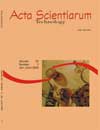Influência da mono-hidrogenação da fração C5 na síntese do TAME usando Amberlyst 15 como catalisador
DOI:
https://doi.org/10.4025/actascitechnol.v23i0.2773Palavras-chave:
TAME, hidrogenação, Amberlyst 15Resumo
No presente trabalho, foi estudada a síntese do TAME, em fase líquida, a partir de uma fração C5 e metanol, utilizando Amberlyst 15 como catalisador. A fração C5 utilizada possui uma diolefina, que tem uma alta tendência í formação de gomas e um alto teor de mono-olefinas. Deste modo, o objetivo deste trabalho foi avaliar o efeito da mono-hidrogenação da fração C5 na síntese do TAME. A hidrogenação foi feita a 80oC e 10 kgf/cm2 de H2, usando um catalisador 0,3% Pt/Al2O3. A diolefina foi totalmente hidrogenada e o teor de mono-olefinas significativamente reduzido sem um decréscimo apreciável no teor de isoamilenos reativos. A eterificação foi feita em um reator tipo batelada de 250 mL, com agitação magnética. A temperatura foi variada na faixa de 50 a 90oC, com uma pressão de 10 kgf/cm2 e razão molar isoamileno/metanol de aproximadamente um. Os produtos de reação foram analisados por cromatografia gasosa. A conversão total observada foi aproximadamente a mesma para o os cortes original e mono-hidrogenado. Entretanto, os produtos obtidos utilizando a fração C5 original apresentaram cheiro forte e coloração, mesmos para os testes a temperaturas mais baixas, que são características da formação de gomas. Por outro lado, quando a fração mono-hidrogenada foi usada na eterificação, o cheiro forte e coloração não foram observados. Portanto, a mono-hidrogenação da fração C5 contendo os isoamilenos reativos é necessária para que o TAME produzido na reação de eterificação possa ser adicionado í gasolinaDownloads
Downloads
Publicado
Como Citar
Edição
Seção
Licença
DECLARAÇíO DE ORIGINALIDADE E DIREITOS AUTORAIS
Declaro que o presente artigo é original, não tendo sido submetido í publicação em qualquer outro periódico nacional ou internacional, quer seja em parte ou em sua totalidade.
Os direitos autorais pertencem exclusivamente aos autores. Os direitos de licenciamento utilizados pelo periódico é a licença Creative Commons Attribution 4.0 (CC BY 4.0): são permitidos o compartilhamento (cópia e distribuição do material em qualqer meio ou formato) e adaptação (remix, transformação e criação de material a partir do conteúdo assim licenciado para quaisquer fins, inclusive comerciais.
Recomenda-se a leitura desse link para maiores informações sobre o tema: fornecimento de créditos e referências de forma correta, entre outros detalhes cruciais para uso adequado do material licenciado.



















